Energy & Natural Resources Report
 }
}
At a Glance
- Energy security has moved up the global agenda over the past 18 months, magnifying the trade-offs and complexities involved in navigating the energy transition.
- The tension between energy supply and climate change presents a dual challenge for the 21st century: breaking the historical link between energy and greenhouse gas emissions.
- Solving the challenge will require change on an unprecedented scale and pace, including major infrastructure investments. By one measure, the world needs to nearly triple annual investment in clean energy to reach net-zero emissions by 2050.
- Energy and natural resource companies are and will continue to be at the center of every aspect of the transition to come.
This article is part of Bain’s Energy and Natural Resources Report 2023
The war in Ukraine and ensuing disruption to the global energy system have reminded us all that affordable, reliable energy is the foundation upon which modern civilization rests. From the electricity used to light our homes, to the liquid fuels powering cars and planes, to the energy needed to produce fertilizer for growing our food, energy is integral to everything we do.
The massive expansion of primary energy supply since the 19th century has driven an unparalleled improvement in human longevity and prosperity. However, those benefits haven’t been equally distributed. There is still considerable energy poverty, concentrated primarily in the Global South. About 675 million people lack access to electricity, and 2.3 billion people—almost 30% of the world’s population—don’t have access to clean cooking fuels and technologies that prevent premature death from indoor air pollution. Future population growth will be overwhelmingly concentrated in these regions, with the population of sub-Saharan Africa alone expected to almost double (see Figure 1).
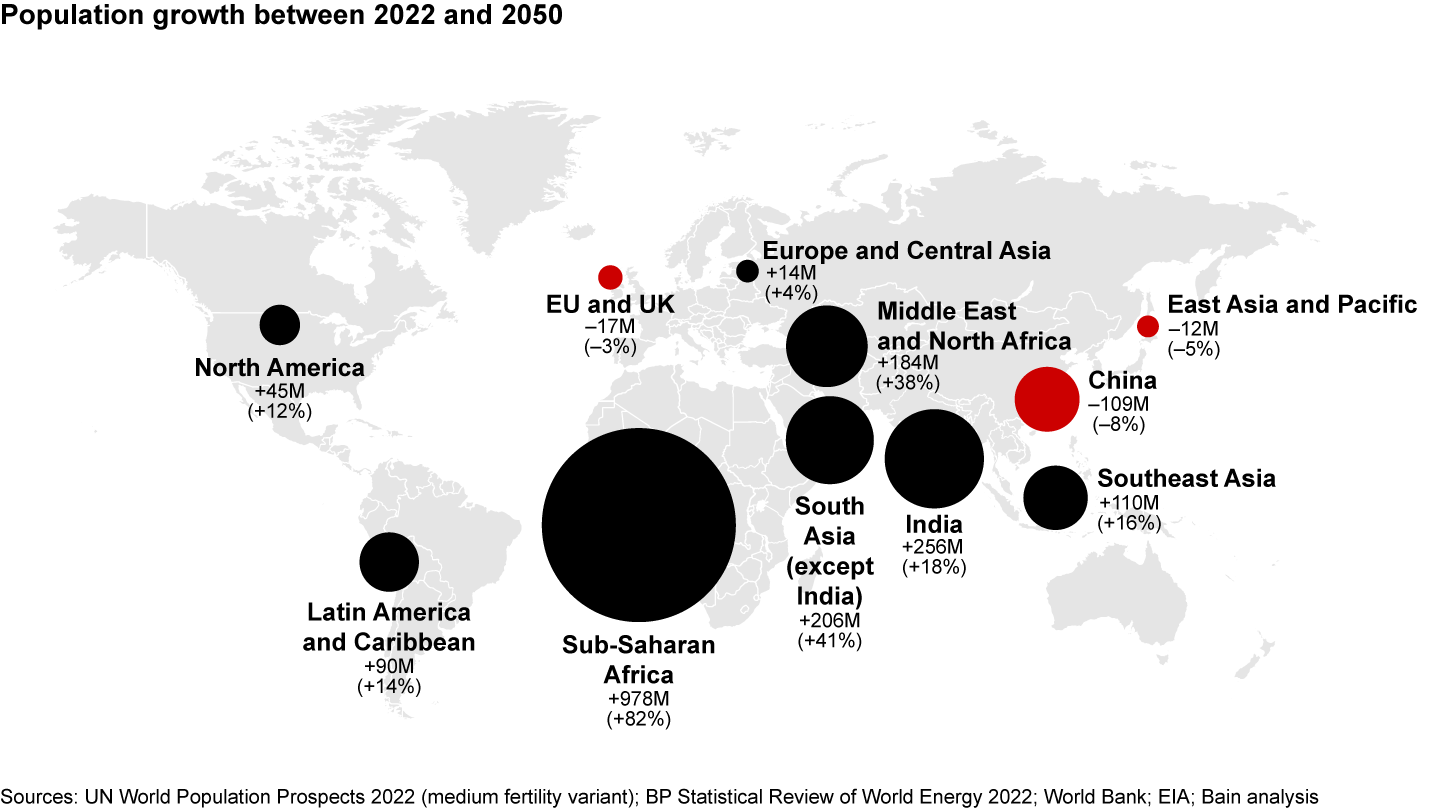
The world needs more energy.
Yet our largest primary energy sources, fossil fuels, are also the largest sources of anthropogenic greenhouse gas emissions. Fossil fuels account for around 80% of our primary energy supply, and our reliance on them has not changed appreciably in 30 years. Rising greenhouse gas concentration in the atmosphere, produced in large part by the production and combustion of fossil fuels, is causing the planet to warm, and there is now clear scientific consensus that adverse consequences for human prosperity and well-being will result if this warming trend continues.
The tension between energy supply and climate change presents a dual challenge for the 21st century. How will the world increase energy supply while simultaneously curbing emissions?
The scale and pace of change required to solve the challenge are unprecedented and extraordinary. By one well-known measure, the IEA’s Net Zero Emissions by 2050 Scenario, the world would need to approximately double its 2022 pace of total energy investment by 2030 and sustain this level, or slightly lower, through 2050 to achieve net-zero emissions. This includes nearly tripling annual investment in clean energy.
Many energy and natural resource executives are acutely aware of these realities. But as energy security has moved up the global agenda over the past 18 months, the difficult road ahead for the energy transition has become even clearer.
Energy and natural resource companies are and will continue to be at the center of every aspect of the unfolding transition, and how these companies navigate the accompanying opportunities and risks will have major implications for how the dual challenge ultimately plays out. (Read the next chapter of the report for more detail.)
The need for more energy
The world must increase its energy supply to support human well-being and economic growth. Historically, global energy consumption, population, and gross domestic product have grown in tandem (see Figure 2). In less mature economies, small increases in energy consumption per capita are strongly associated with significant gains in the Human Development Index, a United Nations composite measure comprised of indicators for health, education, and income—supporting the notion that energy is critical to human prosperity.
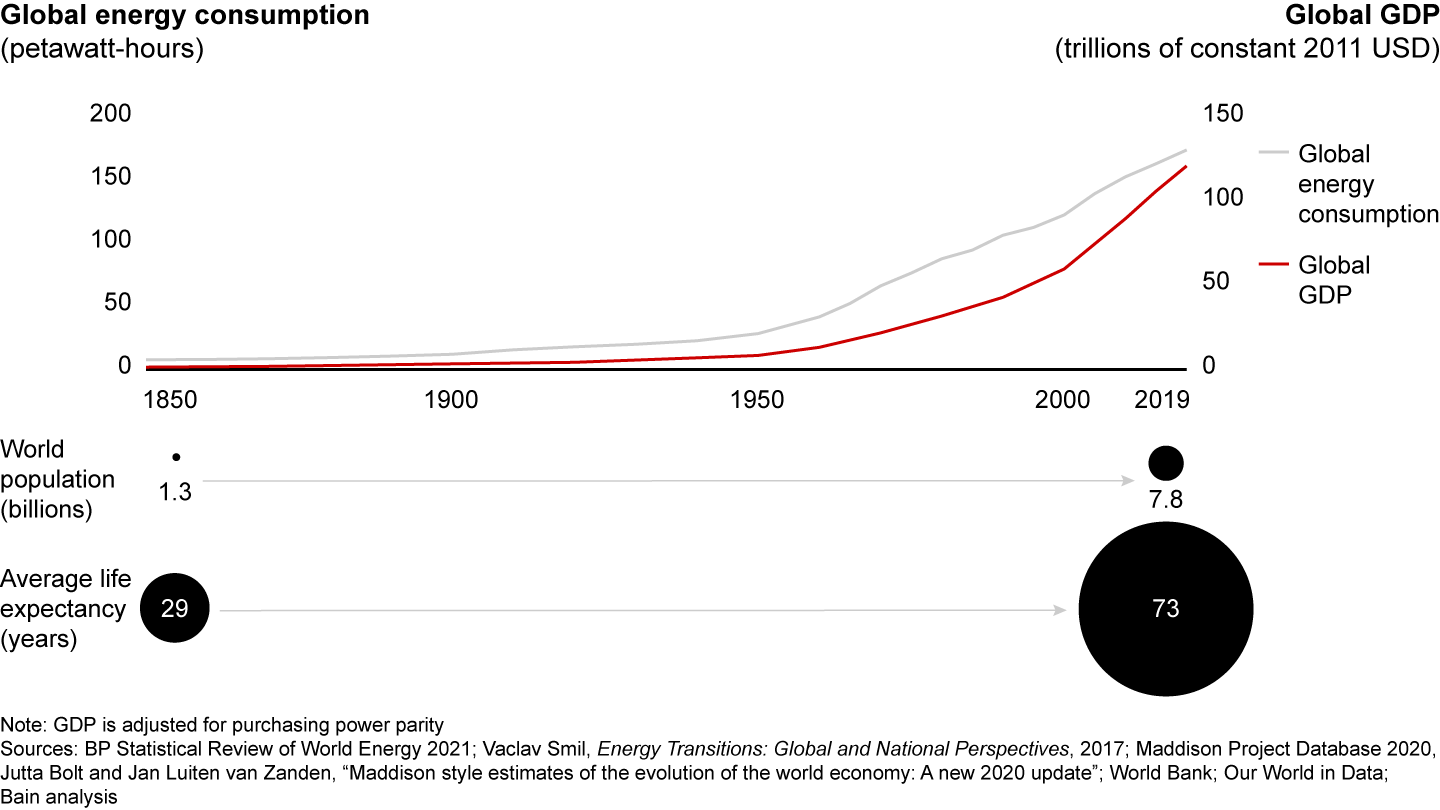
Despite substantial growth in the world’s energy supply over the last 150 years, billions of people still don’t have access to enough affordable, reliable energy. Population growth over the next three decades will be overwhelmingly concentrated in these regions. Their populations and governments will continue to focus on expanding their energy supplies—including electricity generation and infrastructure, among other areas—to support economic development and improve living standards (see Figure 3).
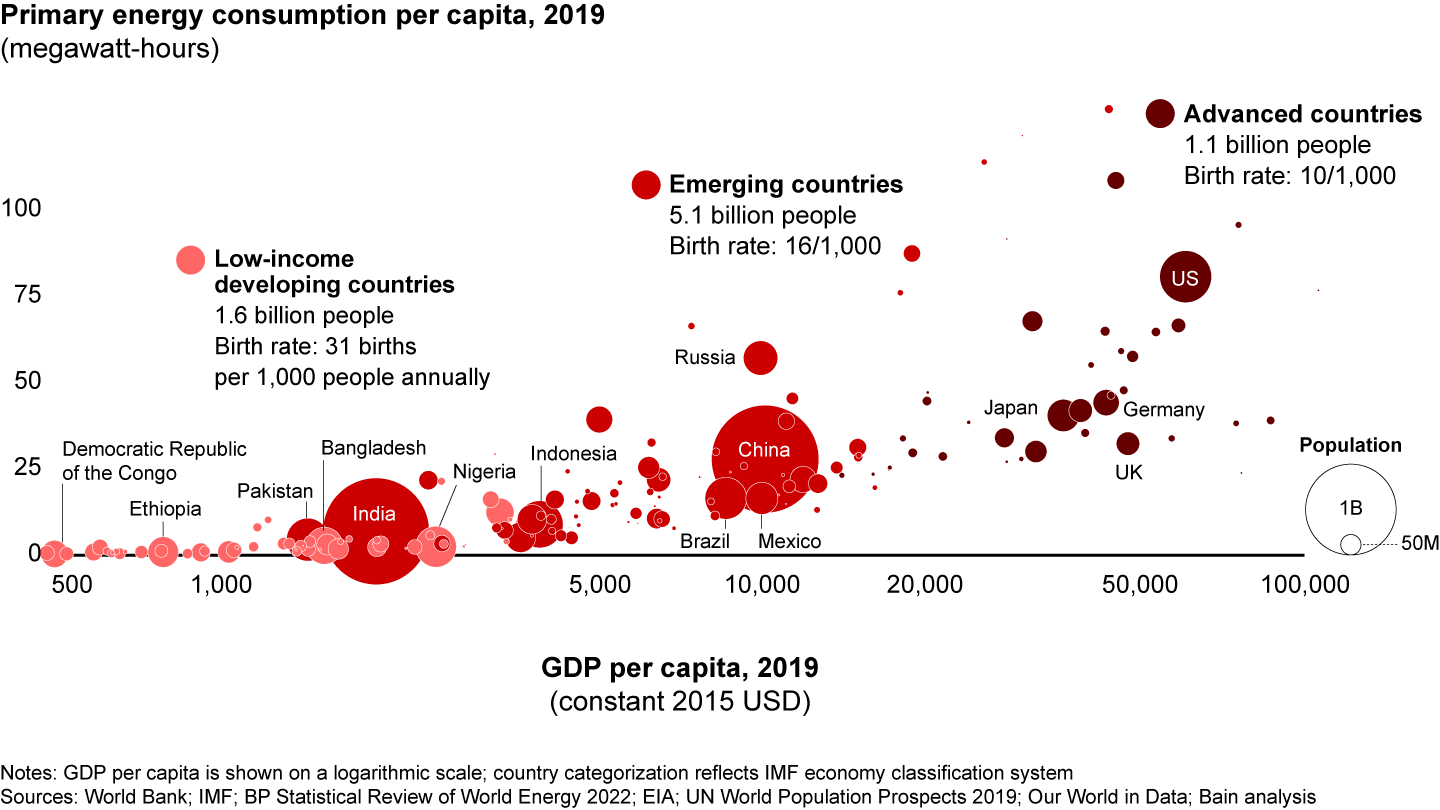
To put the need for increasing the world’s energy supply in even starker terms, consider the following thought experiment. Say that India, Indonesia, Pakistan, Nigeria, and other countries with low or very low energy consumption per capita today were to increase per capita consumption by 2050 to the level of, for example, Mexico in pursuit of economic growth, a desirable goal. Global primary energy consumption would then grow by about 70 petawatt-hours, or approximately 45% of total global energy supply as of 2019.
Efficiency gains, including from electrification and increased renewable energy use, will offset some of the future demand. So far, however, only advanced economies comprising a minority of the global population have decoupled economic growth from energy consumption (see Figure 4).
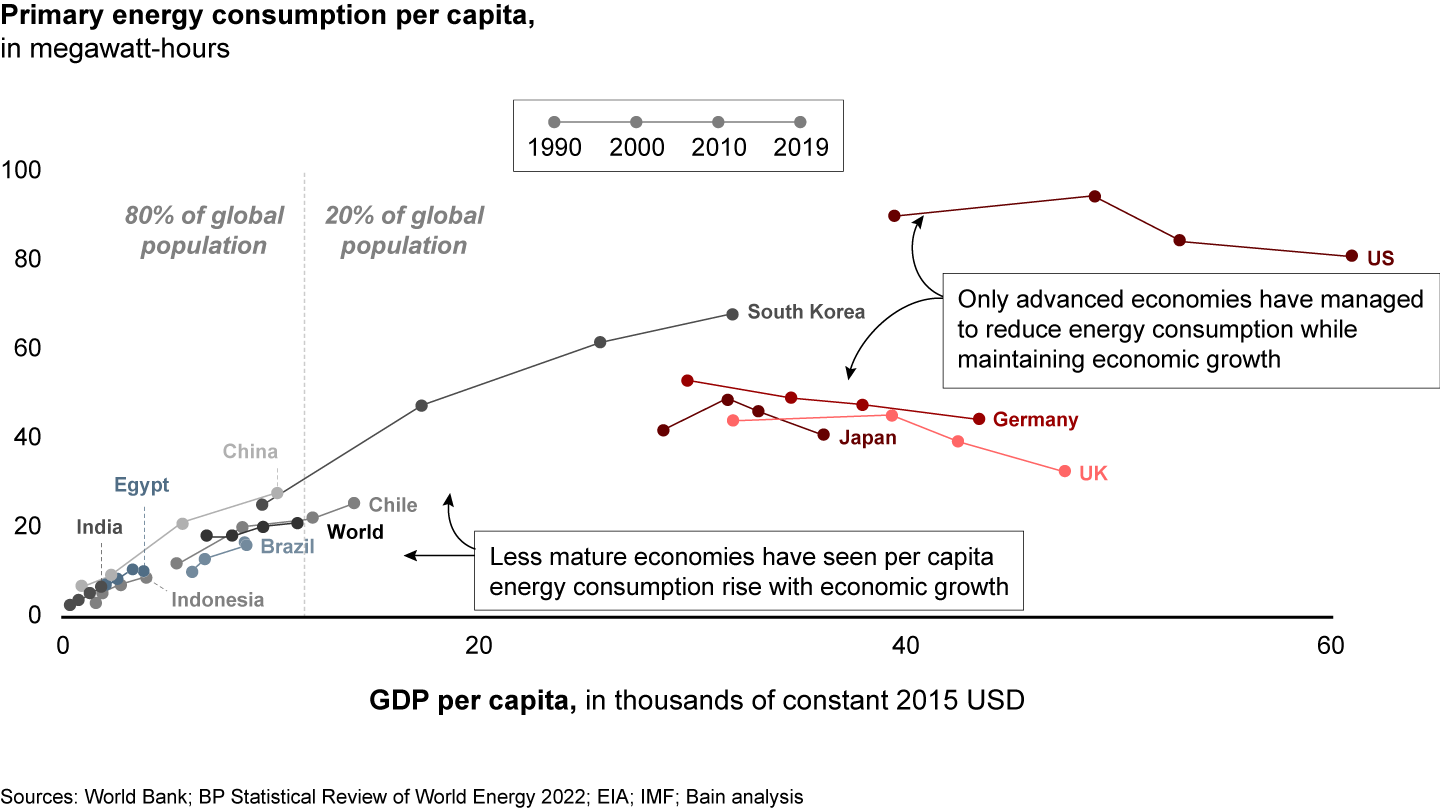
Consequences of business as usual
Absent action both to decarbonize our existing energy supply and to avoid further emissions as developing economies advance, significant risks emerge—and these risks aren’t uniformly shared across the world.
As human-induced climate change is principally a function of the atmospheric concentration of gases like carbon dioxide, the cumulative emissions total over a period of decades matters. Human activity has caused the release of more than 2 trillion cumulative tons of carbon dioxide worldwide since 1850, and about 45% of that was emitted between 1990 and 2021 (see Figure 5).
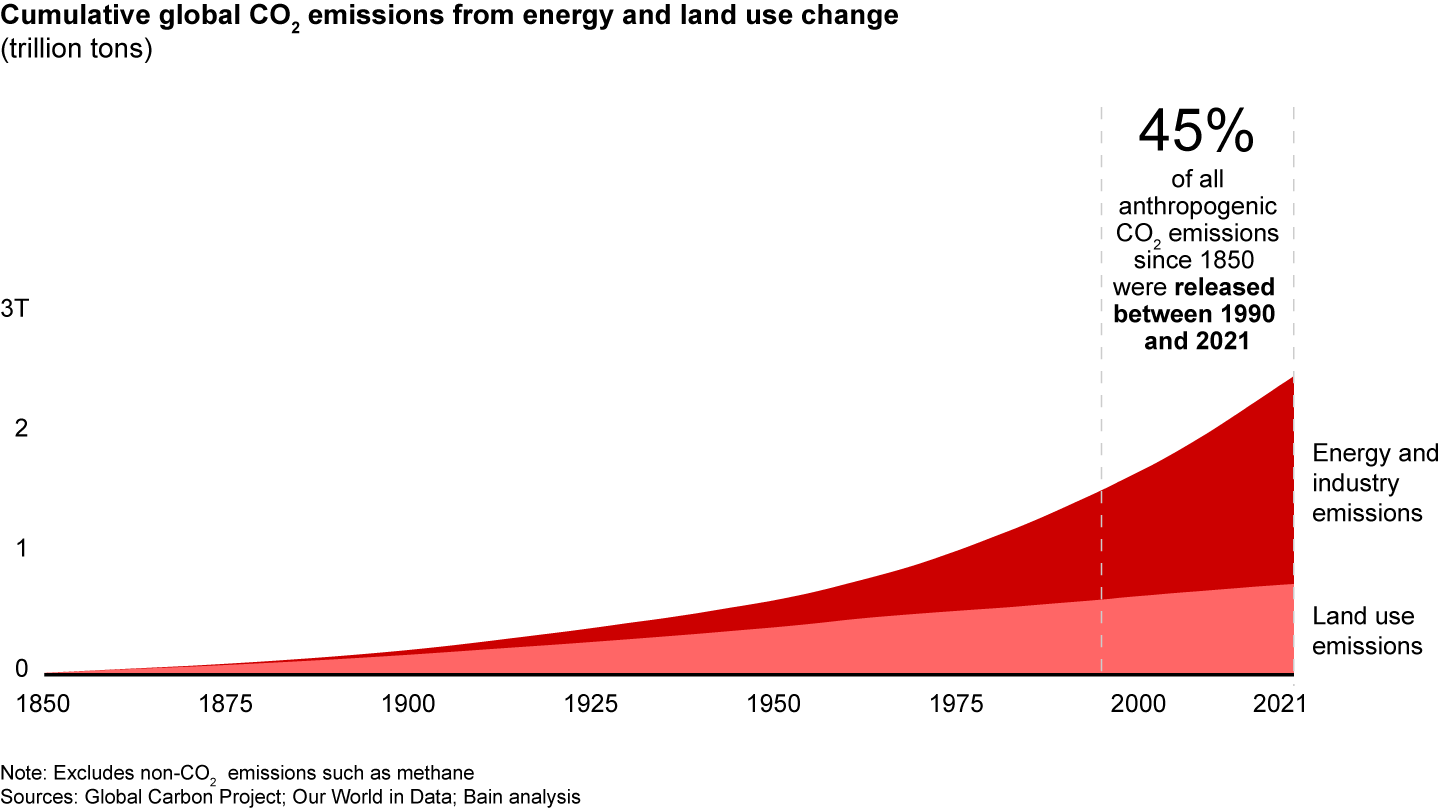
It’s worth noting that the world has made some progress toward climate targets in recent years. After the Paris Agreement in 2015 and ensuing policy commitments by national governments, the temperature estimates for end-of-century warming had fallen by around a half-degree Celsius as of 2020. Still, global CO2 emissions from fossil fuels reached a new high in 2022, and there’s no sign that emissions have peaked.
Warming caused by human activity has already produced adverse impacts on both natural and human systems, including increased food and water insecurity; damage to terrestrial, freshwater, coastal, and ocean marine ecosystems; and species losses. Continued warming will very likely lead to higher frequency and intensity of certain types of extreme weather, such as extreme heat events, heavy precipitation events, and severe agricultural or ecological droughts.
What’s more, future risks aren’t uniformly distributed, with Southeast Asia and sub-Saharan Africa disproportionately exposed to the negative consequences (see Figure 6).
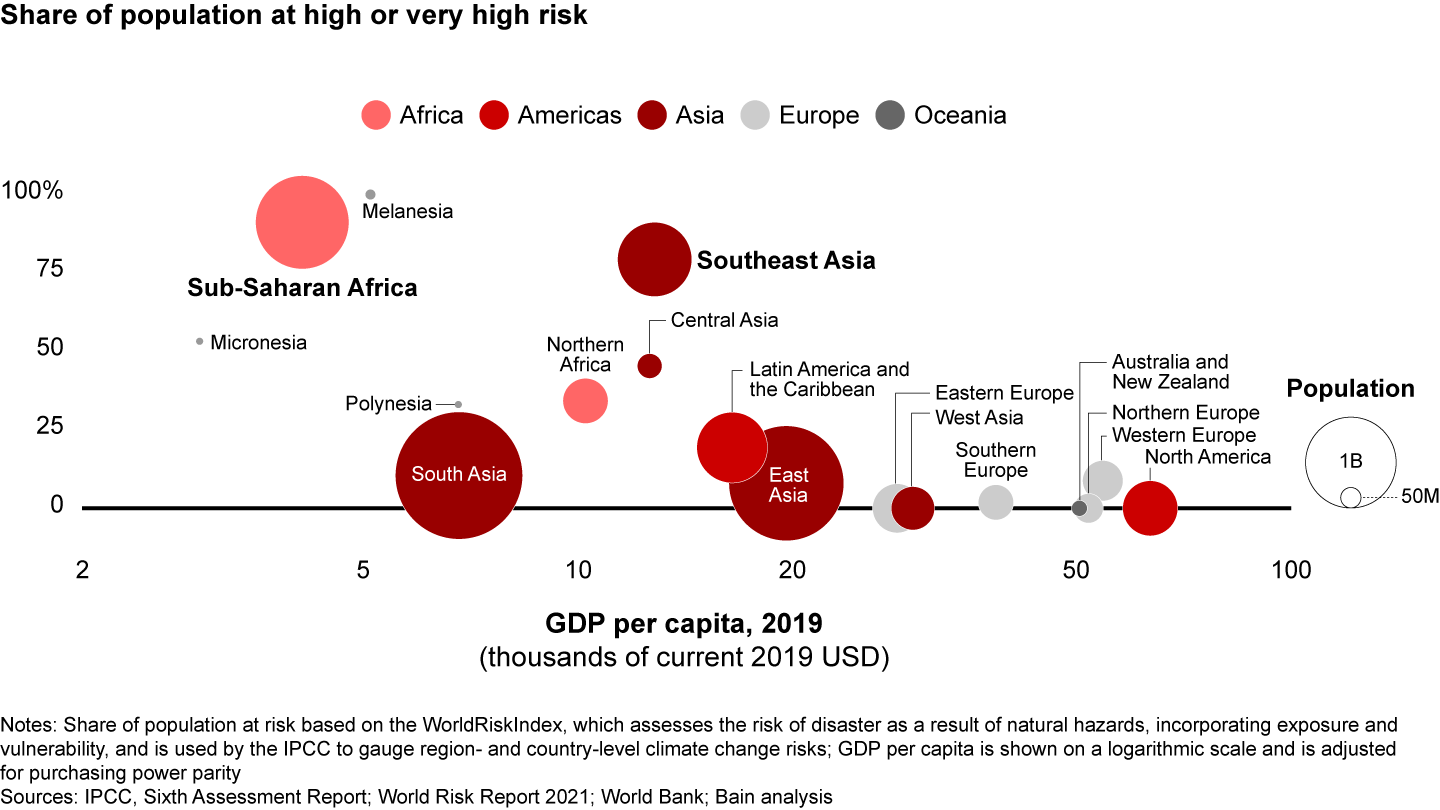
The pace and frictions of change
Avoiding the worst risks of climate change will require the world to reduce and eventually eliminate greenhouse gas emissions produced by human activity. Scenarios in which the average increase in global surface temperature is held below 2 degrees Celsius by 2100 imply massive, nearly immediate, and sustained emissions reductions; by 2050, the level of anthropogenic greenhouse gas emissions would need to be at least 60% lower than it is today.
Achieving this would necessitate substantial, rapid changes to our energy system, which is responsible for about three-quarters of anthropogenic greenhouse gas emissions. Doing this in 27 years would be unprecedented. History suggests turning over even one-quarter of the global energy supply takes at least three decades, reflecting the asset intensity of the energy system. It’s notable that each time the world transitioned to a new primary energy source, from coal to crude oil to natural gas, the displaced primary fuel source didn’t disappear. In fact, the quantity of primary energy supplied by coal, oil, and gas is today at or near all-time highs.
The physical scale of what must be addressed is hard to comprehend. Consider, as one example, our energy production and processing infrastructure, which is capable of handling more than 15 billion tons of coal, oil, and gas extraction, processing, and distribution each year. This infrastructure includes an oil and gas pipeline system that, if lined up end to end, would wrap around Earth nearly 30 times.
Unsurprisingly, the amount of capital required to replace, repurpose, or otherwise mitigate the warming impact of our energy system so quickly is enormous. And that doesn’t include the significant capital required to build entirely new energy infrastructure to support rising demand in places currently experiencing energy poverty. In our view, very few components of the energy system are prepared for change at the scale and pace required.
Defining the tension
Putting these elements together, a picture emerges of the extraordinarily challenging path we must take to resolve the dual challenge (see Figure 7).
First, it’s imperative that the world reduce anthropogenic greenhouse gas emissions to limit the negative impacts of climate change, but we’re not on track for a scenario in which the world warms less than 2 degrees Celsius above preindustrial levels (see first panel in the chart below). At the same time, energy supply will likely need to increase in the coming decades to support economic growth and enhance human well-being, though efficiency gains will provide some buffer (see second panel). Adding these factors together, we arrive at the target scenario in the third panel: bending the emissions curve while still serving higher energy demand. Breaking the relationship between energy and emissions is at the heart of the dual challenge. The essence of it is achieving “low carbon” without compromising “reliable, affordable, and secure” as the energy supply expands.
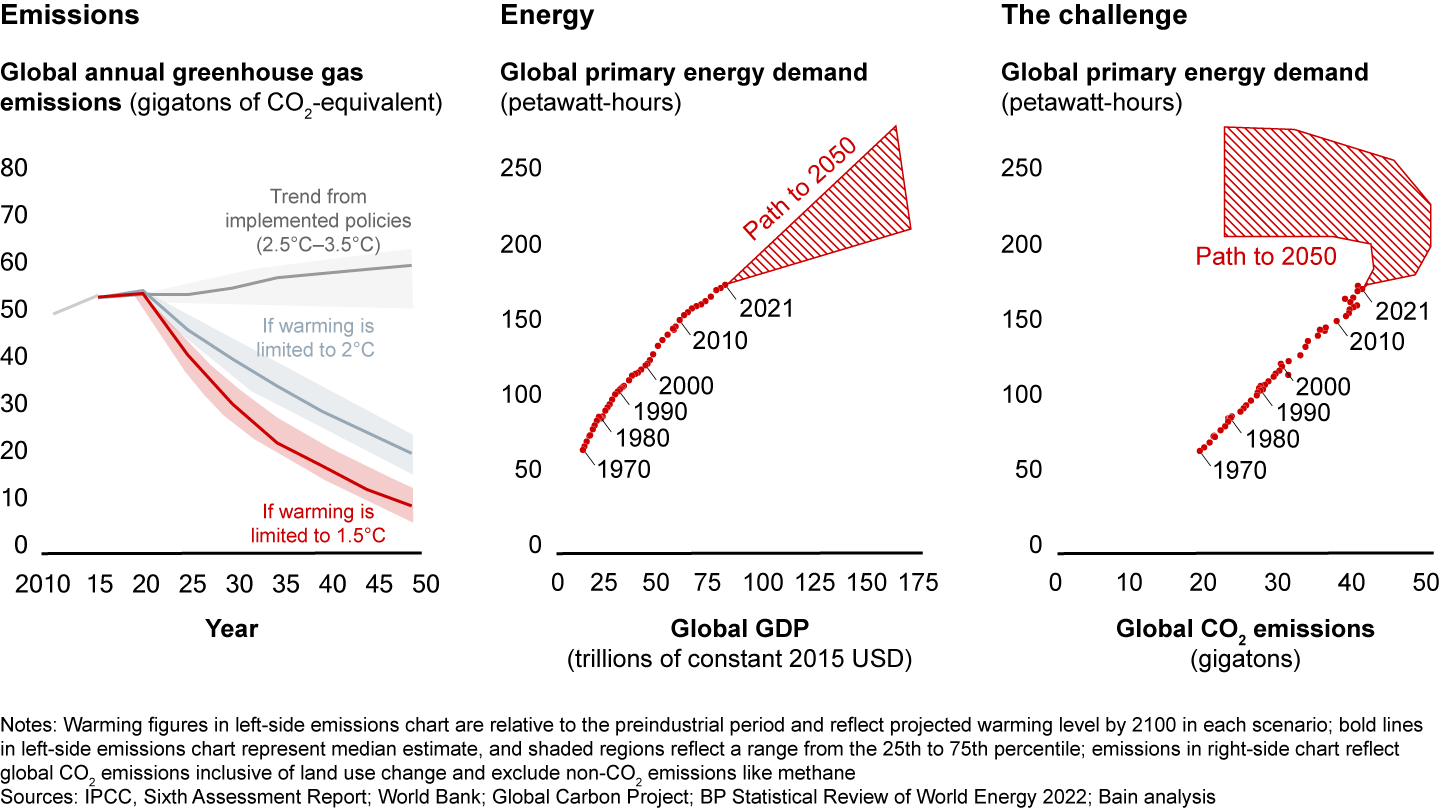
Importantly, the journey will be different for every country. In low-income developing and emerging economies, the objective is to lift countries out of energy poverty and support industrialization in a low-carbon way, without erecting barriers to economic development (i.e., without following the historical trajectory of advanced economies). In advanced economies, it’s about reducing emissions while maintaining high living standards and economic growth. Companies that succeed will work in increasingly localized ways to support the energy and carbon journeys of different countries worldwide.
Solving the dual challenge will be enormously difficult due to its colossal scale and complexity and the importance to society of what we must replace or augment. The cost of failure in either direction is high: a rapidly warming planet and the consequential environmental risks, or stifled economic progress and lingering quality-of-life concerns for the billions of people who lack access to sufficient energy. But the outcome is not predestined, and it will depend on the actions we take to address the challenge.






